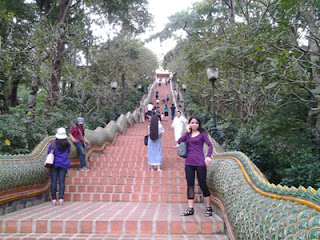Chiang Mai is not just a place to visit temples and night markets: it is also a city with a thriving nightlife. It is Thailand’s second city and has everything (or nearly everything) that you can find in Bangkok. The nightlife might not be as seedy, as swank, as boutique, or as hi so as places in the capital but for many they actually prefer the more relaxed nightlife atmosphere of Chiang Mai.
One of the best nightclubs in Chiang Mai is aptly named Infinity. It is a large nightclub aimed at hip Thais. It is well furbished and stylish. Infinity looks like the type of nightclub many foreigners might avoid thinking it would be too expensive. However that is not the case: drinks are reasonably priced and cheaper than in many fashionable spots in Chiang Mai.
It gets packed at the weekend. Weeknights can be lively without getting too busy. A number of DJs play house music. They also have live bands. While the music is often geared towards a Thai crowd, they mix it up with plenty of tunes that will appeal to most people.
The club tends to fill up after the other bars and clubs shut at 1am or 2am. Infinity has a large outdoor seating area with lots of seating that attracts the late night drinking crowd.
Infinity has a great sound system and impressive lights and other effects. It is a high energy place. If you are up for having a big night this nightclub is a good option.
Telephone 053 400 085
Address: Nimmana Haeminda Soi 6, Mueang Chiang Mai
One of the best nightclubs in Chiang Mai is aptly named Infinity. It is a large nightclub aimed at hip Thais. It is well furbished and stylish. Infinity looks like the type of nightclub many foreigners might avoid thinking it would be too expensive. However that is not the case: drinks are reasonably priced and cheaper than in many fashionable spots in Chiang Mai.
It gets packed at the weekend. Weeknights can be lively without getting too busy. A number of DJs play house music. They also have live bands. While the music is often geared towards a Thai crowd, they mix it up with plenty of tunes that will appeal to most people.
The club tends to fill up after the other bars and clubs shut at 1am or 2am. Infinity has a large outdoor seating area with lots of seating that attracts the late night drinking crowd.
Infinity has a great sound system and impressive lights and other effects. It is a high energy place. If you are up for having a big night this nightclub is a good option.
Details:
Facebook: https://www.facebook.com/infinity.chiangmaiTelephone 053 400 085
Address: Nimmana Haeminda Soi 6, Mueang Chiang Mai










